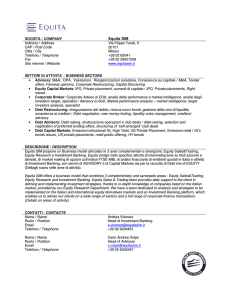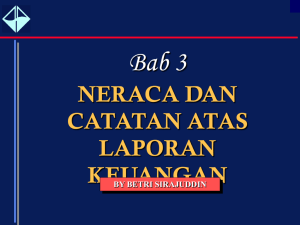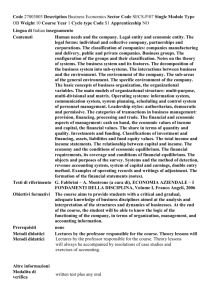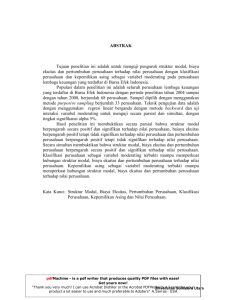*Best Practices* in Estimating the Cost of Capital: Survey and
advertisement
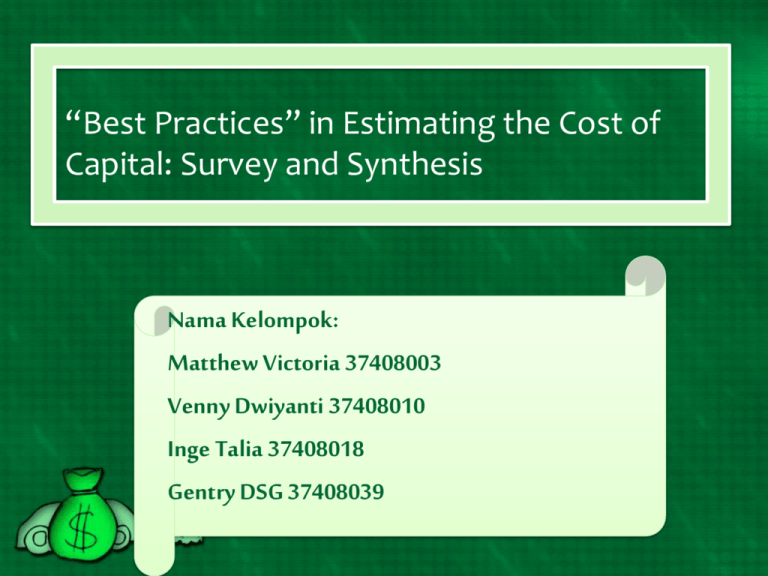
“Best Practices” in Estimating the Cost of Capital: Survey and Synthesis Nama Kelompok: Matthew Victoria 37408003 Venny Dwiyanti 37408010 Inge Talia 37408018 Gentry DSG 37408039 Pengertian cost of capital Cost of capital sisi investor sisi perusahaan Sisi investor = opportunity cost dari dana yang ditanamkan investor pada suatu perusahaan. Sisi perusahaan = biaya yang dikeluarkan oleh perusahaan untuk memperoleh sumber dana yang dibutuhkan • Perhitungan cost of capital sangat penting karena: 1. Membantu perusahaan untuk melakukan bench mark pada perusahaan lain yang cukup baik 2. Membantu membuat keputusan karena cost of capital telah diestimasi I. Weighted Average Cost of Capital (WACC) • Untuk menghitung cost of capital kita menggunakan WACC • WACC adalah rata-rata tertimbang dari seluruh komponen modal • Komponen modal yg sering dipakai adalah: saham biasa, saham preferen, utang, laba ditahan • Seluruh komponen modal ( capital components) mempunyai satu kesamaan, yaitu investor yang menyediakan dana berharap untuk mendapatkan return dari investasi mereka Weighted Average Cost of Capital (WACC) WACC = wd.kd (1-T)+wps.kps+ws.( ks atau ke) kd kps ks ke T = biaya hutang = biaya saham preferen = biaya laba ditahan = biaya saham biasa baru = pajak Hal-hal yang diperhatikan dalam perhitungan WACC 1. Capital cost yang ada menunjukkan kondisi pasar saat ini bukan historical. 2. Bobot yang ada harus dari bobot pasar 3. Cost of debt harus dikurangi pajak Penggunaan hutang sebagai modal, menurunkan penghasilan yg dikenai pajak karena bunga yg harus dibayar. Karena itu penggunaan hutang dapat mengurangi pajak yang dibayar (tax deductible) II. Sample Selection Sample yang digunakan adalah perusahaan Cara yang dilakukan dari sample ini adalah 1.Memberikan surat tentang penelitian 2. Lalu melakukan telepon. Selain perusahaan,sampel yang lain adalah Penasehat keuangan dan text book III. Survey Findings • Discounted cash flow (DCF) is the dominant investmentevaluation technique • WACC is the dominant discount rate used in DCF analyses • Weights are based on market, not book, value mixes of debt and equity • The after tax cost of debt is predominantly based on marginal pretax costs and marginal or statutory tax rates • The capital asset pricing model (CAPM) is the dominant model for estimating the cost of equity Capital Asset Pricing Model (CAPM) Rf = Interest rate available on a risk free bond Rm = Return required to attract investors to hold the broad market portfolio of risky assets β = The relative risk of the particular asset Risk free rate of return • Choice of a risk free rate can have a material effect on the cost of equity and WACC • Long term bond yields more closely reflect default free holding period returns available on long lived investments and thus more closely mirror the types of investments made by companies Risk free rate of return • Our survey results reveal a strong preference on the part of practitioners for long term bond yields. • Many corporations said they matched the term of risk free rate to the tenor of the investment. • Of both corporations and financial advisers, 70% use treasury bond yield and only 4% of the corporations use the treasury bill yield. Beta Estimates • Finance theory calls for a forward-looking beta, one reflecting investor’s uncertainty about the future cash flows to equity. where: Rit = Return on stock I in time period Rmt = Return on the market portfolio in period t αi = Regression constant for stock I βi = Beta for stock i Beta Estimates Compromises underlying beta estimates and their effect on estimated betas Of sample companies Bloomberg Value Line Standard and Poor’s Number of observations Time interval Market index proxy Sample mean beta Sample median beta 102 260 60 Weekly over 2 years S&P 500 1.03 1.00 Weekly over 5 years NYSE composite 1.24 1.20 Monthly over 5 years S&P 500 1.18 1.21 Over half of the corporations in our sample rely on published sources for their beta estimates. Among financial advisers, 40% rely on published sources, 20% calculated their own, and another 40% use what might be called “fundamental” beta estimates Equity Market Risk Premium • Finance theory says the equity market risk premium should equal the excess return expected by investors on the market portfolio relative to riskless assets. • Where respondents chiefly differed was in their use of arithmetic versus geometric average historical equity returns. • Arithmetic mean return is the simple average of past returns. • The geometric mean return is the internal rate of return between a single outlay and one or more future receipts. Equity Market Risk Premium • Of the texts and trade books survey, 71% support use of the arithmetic mean return as the best surrogate for the equity market risk premium. • Ernhardt (1994) recommends use the geometric mean return. Copeland, Koller, and Murrin (1990): “We believe that the geometric average represents a better estimate of investor’s expected returns over long period of time” IV. The Impact of Various Assumptions For Using CAPM The resulting ranges of estimated WACCs for two firms under various combinations of beta, risk free rate, and risk premium : The range from minimum to maximum is large for both firms, and the economic impact is potentially stunning. V. Risk Adjustment To WACC • Financial Theory : A firm’s overall WACC is a suitable benchmark for a firm’s average risk investments. • The fact : • Earlier studies ( summarized in Gitman And Mercio ( 1982 )) reported that between a half of firms surveyed did not adjust for risk differences among capital project • When asked about risk adjustment, these firms responded as follows : • “We make these adjustment in cash flow rather than in discount rates” • “Risk factor may be different for realization of synergies, but we make adjustment to cash flow rather than the discount rates” • Why do practitioners risk-adjust discount rates in one case and work with cash-flow adjustment in another ? • Our interpretation is that risk-adjusted discount rates are more likely used when the analyst can establish relatively objective financial market benchmark for what rate adjustment should be • Sometimes when the analyst is lack of good market analog, the analyst is forced to rely more on internal focus • The conclusion : Practical implementation of risk adjusted discount rates thus appear to depend on the ability to find traded financial assets that are comparable in risk to the cash flow being valued and then to have financial data on these traded asset. VI. Conclusions • The survey revealed broad acceptance of the WACC as the basis for setting discount rates. • In summary, we believe that the following elements represent “best current practice” in the estimation of WACC : • Weight should be based on market-value mixes of debt and equity • The after-tax cost of debt should be estimated from marginal pretax costs, combined with marginal tax rates • CAPM is currently the preferred model for estimating the cost of equity • Betas are drawn substantially from published sources • Risk-free rate should match the tenor of the cash flow being valued • Choice of an equity market risk premium is the subject of considerable controversy both as to its value and method of estimation • Monitoring for changes in WACC should be keyed to major changes in financial market conditions, but should be done at least annually • WACC should be risk adjusted to reflect substantive differences among different business in a corporation Nike Inc. Cost of capital Background • Pada bulan Juli 2001 , Kimi Ford seorang manajer portofolio dari North Point Group berencana untuk membeli saham Nike yang merupakan manufaktur sepatu olahraga . • Harga Saham Nike sedang turun secara signifikan sejak awal tahun dan Kimi berencana untuk menambah jumlah saham dalam pengelolaanya yaitu NorthPoint Large-Cap Fund , yang telah berinvestasi di 500 perusahaan besar seperti ExxonMobil,GM,Mcdonald,dsb . • Performa NorthPoint Large-Cap Sangat bagus di tahun 2000 yaitu mendapat return 20,7% saat return S&P 500 turun 10.1%. Pada tanggal 28 juni 2001 , Nike mengadakan meeting untuk membahas kinerjanya di tahun 2001 yang dirasa kurang maksimal yaitu : • Sejak tahun 1997 revenue nike tetap berkutat di kisaran $9 Billion . • Net income yang menurun dari $800 million di tahun 1997 menjadi $580 million di tahun 2001 . • Market Share Nike yang menurun dari 48% di tahun 1997 menjadi 42% di tahun 2000. Rencana kebijakan Manajemen yang diambil oleh Nike yaitu : • Untuk meningkatkan Revenue Nike berencana mengembangkan sepatu olahraga di midpriced segment (segmen tengah). • Nike berencana untuk mendorong produk Pakaian (apparel) karena dirasa mampu bersaing di pasar. • Nike akan mengusahakan cost control yang lebih efisien dari tahun ke tahun. • Nike merencanakan Long Term Revenue Target sebesar 8-10% dan Earning Growth target Sebesar 15% Reaksi Analis terhadap kebijakan tersebut berbeda-beda : • Lehman Brothers pada saat itu merekomendasikan “Strong Buy”. • CSFB dan UBS Warburg merekomendasikan “Hold”. Kimi kemudian menghitung DCF forecast dan menemukan kesimpulan bahwa dengan Discount Rate 12% maka harga saham Nike pada saat itu ($42.09) adalah Overvalued dan jika Discount Rate dibawah 11.2% maka harganya Undervalued. Maka dari itu kimi meminta Joanna Cohen untuk mengestimasi Cost of Capital dari Nike . Consolidated Income Statement Income Statement 1995 1996 1997 1998 1999 2000 2001 Revenues 4,760.8 6,470.6 9,186.5 9,553.1 8,776.9 8,995.1 9,488.8 COGS 2,865.3 3,906.7 5,503.0 6,065.5 5,493.5 5,403.8 5,784.9 Gross Profit 1,895.5 2,563.9 3,683.5 3,487.6 3,283.4 3,591.3 3,703.9 Selling and Admin 1,209.8 1,588.6 2,303.7 2,623.8 2,426.6 2,606.4 2,689.7 Operating Income 685.7 975.3 1,379.8 863.8 856.8 984.9 1,014.2 Interest Expense 24.2 39.5 52.3 60.0 44.1 45.0 58.7 Other Exp. 11.7 36.7 32.3 20.9 21.5 23.2 34.1 - 129.9 45.1 (2.5) - Restructuring Charge,net - - Income before Taxes 649.8 899.1 1,295.2 653.0 746.1 919.2 921.4 Income Taxes 250.2 345.9 499.4 253.4 294.7 340.1 331.7 Net Income 399.6 553.2 795.8 399.6 451.4 579.1 589.7 Growth & Margins Growth(%) 1996 1997 1998 1999 2000 2001 Revenue 35.9 42.0 4.0 (8.1) 2.5 5.5 Operating Income 42.2 41.5 (37.4) (0.8) 15.0 3.0 Net Income 38.4 43.9 (49.8) 13.0 28.3 1.8 Margin(%) 1996 1997 1998 1999 2000 2001 Gross Margin 39.6 40.1 36.5 37.4 39.9 39.0 Operating Margin 15.1 15.0 9.0 9.8 10.9 10.7 Net Margin Tax Rate (Statutory+State) 8.5 8.7 4.2 5.1 6.4 6.2 38.5 38.6 38.8 39.5 37.0 36.0 Assumptions & DCF Analysis Assumptions (%) 2002 2003 2004 2005 2006 2007 2008 2009 2010 2011 Rev. Grwoth 7.0 6.5 6.5 6.5 6.0 6.0 6.0 6.0 6.0 6.0 COGS/Sales 60.0 60.0 59.5 59.5 59.0 59.0 58.5 58.5 58.0 58.0 S&A/Sales 28.0 27.5 27.0 26.5 26.0 25.5 25.0 25.0 25.0 25.0 Tax Rate 38.0 38.0 38.0 38.0 38.0 38.0 38.0 38.0 38.0 38.0 CA/Sales 38.0 38.0 38.0 38.0 38.0 38.0 38.0 38.0 38.0 38.0 CL/Sales 11.5 11.5 11.5 11.5 11.5 11.5 11.5 11.5 11.5 11.5 1,218.4 1,351.6 1,554.6 1,717.0 1,950.0 2,135.9 2,410.2 2,554.8 2,790.1 2,957.5 463.0 513.6 590.8 652.5 741.0 811.7 915.9 970.8 1,060.2 1,123.9 755.40 838.00 963.80 1,064.50 1,209.00 1,324.20 1,494.30 1,584.00 1,729.90 1,833.60 - - - - - - - - - Discounted Cash Flow Operating Income Taxes NOPAT CAPEX,net of dep Change In NWC FCF - 8.8 (174.9) (186.3) (198.4) (195.0) (206.7) (219.1) (232.3) (246.2) (261.0) 764.20 663.10 777.50 866.10 1,014.00 1,117.50 1,275.20 1,351.70 1,483.70 1,572.60 Terminal Value (3%) 17,998.7 Total Flows 764.20 663.10 777.50 866.10 1,014.00 1,117.50 1,275.20 1,351.70 1,483.70 19,571.30 PV of Flows (12%) 682.32 528.62 553.41 550.42 575.37 566.16 576.84 545.93 535.04 6,301.43 Enterprise Value 11,415.54 Current Outstanding Debt 1296.6 Equity Value 10,118.94 Current Shares Outstanding 271.5 Equity Value PerShare Current Share Price $ $ 37.27 42.09 Sensitivity Discount Rate Equity Value 8% $ 75.80 8.50% $ 67.85 9% $ 61.25 9.50% $ 55.68 10% $ 50.92 10.50% $ 46.81 11% $ 43.22 11.17% $ 42.09 11.50% $ 40.07 12% $ 37.27 Consolidated Balance Sheet Balance Sheet , May 31 Assets Current Assets : Cash Acc Recievable Inventories Deffered Income Taxes Prepaid Exp Total Current Asset Property,Plant,Equipment Intangible Asset&Goodwill Deffered Income Taxes Total Assets 2000 2001 254.3 1,569.4 1,446.0 111.5 215.2 3,596.4 1,583.4 410.9 266.2 5,856.9 304.0 1,621.4 1,424.1 113.3 162.5 3,625.3 1,618.8 397.3 178.2 5,819.6 Balance Sheet , May 31 Liabilities & Equity Curent Liabilities : Current Long-term Debt Notes Payable Acc Payable Accrued Liabilities Income Tax Payable Total Current Liabilities Long Term Debt Deffered Income Taxes Redeemable Pref Stock Total Liabilities Equity : Common Stock Capital in Exces of stated Value Unearned Compensation Accumulated Other Income Retained Earnings Total Equity Total Liabilites And Equity 2000 2001 50.1 924.2 543.8 621.9 2,140.0 470.3 110.3 0.3 2,720.9 5.4 855.3 432.0 472.0 21.9 1,786.6 435.9 102.2 0.3 2,325.0 2.8 369.0 (11.7) (111.1) 2,887.0 3,136.0 5,856.9 2.8 459.4 (9.9) (152.1) 3,194.3 3,494.5 5,819.5 Financial Information Current Yield on US Treasuries Historical Equity Risk Premium (1926-2000) 3 Month 3.59% Gemotric Mean 5.90% 6 Month 3.59% Arithamtic Mean 7.50% 1 Year 3.59% 5 Year 4.88% Current Yield on Nike Debt 10 Year 5.39% Coupon 20 Year 5.74% Issued Maturity Nike Average Historic Betas 1996-2000 Current Price 0.8 Semi 6.75%Annual 7/15/19 96 7/15/20 21 $ 95.6 Joanna Cohen’s Analysis • A. Single atau Multiple Cost of Capital ? Cohen menggunakan Single Cost of Capital karena dia berasumsi meskipun Nike memproduksi beraneka ragam produk seperti Sepatu, Pakaian , Bola , Kacamata , Aksesoris , dan Perlengkapan Olahraga lainya tetapi sebagian besar adalah Bisnis dalam bidang Olahraga dan produksi yang diluar olahraga hanya menyumbang revenue yang kecil . Dan Juga distribusi dan Marketingnya tetap berada pada satu Channel. • B. Methodology Perhitungan Weight Capital Sources Debt Current Long-Term Debt Notes Payable Long Term Debt Total Debt Equity Total Capital Book Values 5.4 855.3 435.9 1296.6 3494.5 4791.1 27% 73% • C. Cost of Debt Cohen menggunakan Cost of Debt dengan perhitungan interest expense / average debt balance sehingga menghasilkan Cost of Debt sebesar 4.3% • D. Cost of Equity CAPM = RF + B *RPM = 5.74% + 0.8 * 5.9% = 10.5% • E. WACC WACC = Kd (1-t) * Wd + Ke * We = 4.3 * (1-38%) * 27% + 10.5% * 73% = 8.4% Jan-01 Apr-01 Jul-01 Oct-01 Jan-02 Apr-02 Jul-02 Oct-02 Jan-03 Apr-03 Jul-03 Oct-03 Jan-04 Apr-04 Jul-04 Oct-04 Jan-05 Apr-05 Jul-05 Oct-05 Jan-06 Apr-06 Jul-06 Oct-06 Jan-07 Apr-07 Jul-07 Oct-07 Jan-08 Apr-08 Jul-08 Oct-08 Jan-09 Apr-09 Jul-09 Oct-09 Jan-10 Apr-10 Jul-10 Oct-10 Nike Share Price Price 99.03 90.69 55.02 41.99 56.24 53.65 53.49 86.6 86.79 75.75 81 81.1 68.46 64.24 58.29 66.07 67.55 59.61 51 51.78 44.47 Group’s Analysis 2010 Total Revenue Cost of Revenue, Total Gross Profit 2010 2009 2008 2007 2006 19,014.00 19,176.10 18,627.00 16,325.90 14,954.90 10,213.60 10,571.70 10,239.60 9,165.40 8,367.90 8,800.40 8,604.40 8,387.40 7,160.50 6,587.00 Selling/General/Administrative Expenses, Total Research & Development Depreciation/Amortization Interest Expense (Income), Net Operating Unusual Expense (Income) Other Operating Expenses, Total Operating Income 6,326.40 0 0 0 0 -12.8 2,516.90 6,149.60 0 0 0 596.3 -48.3 1,956.50 5,953.70 0 0 0 0 46.6 2,502.90 5,028.70 0 0 0 0 48.8 2,199.90 4,477.80 0 0 0 0 54.9 2,141.60 Interest Income (Expense), Net Non-Operating Gain (Loss) on Sale of Assets Other, Net Income Before Tax 0 0 0 2,516.90 0 0 0 1,956.50 0 0 0 2,502.90 0 0 0 2,199.90 0 0 0 2,141.60 Income Tax - Total Income After Tax 610.2 1,906.70 469.8 1,486.70 619.5 1,883.40 708.4 1,491.50 749.6 1,392.00 Minority Interest Equity In Affiliates U.S. GAAP Adjustment Net Income Before Extra. Items 0 0 0 1,906.70 0 0 0 1,486.70 0 0 0 1,883.40 0 0 0 1,491.50 0 0 0 1,392.00 Total Extraordinary Items Net Income 0 1,906.70 0 1,486.70 0 1,883.40 0 1,491.50 0 1,392.00 Assets 2010 2009 2008 2007 2006 Cash and Short Term Investments Cash & Equivalents Short Term Investments 5,145.90 3,079.10 2,066.80 3,455.10 2,291.10 1,164.00 2,776.10 2,133.90 642.2 2,847.00 1,856.70 990.3 2,303.00 954.2 1,348.80 Total Receivables, Net 2,649.80 2,883.90 2,795.30 2,494.70 2,382.90 Accounts Receivable - Trade, Net 2,649.80 2,883.90 2,795.30 2,494.70 2,382.90 Accounts Receivable - Trade, Gross 2,766.50 2,994.70 2,873.70 2,566.20 2,450.50 Provision for Doubtful Accounts Total Inventory Prepaid Expenses Other Current Assets, Total Total Current Assets -116.7 2,040.80 873.9 248.8 10,959.20 -110.8 2,357.00 765.6 272.4 9,734.00 -78.4 2,438.40 602.3 227.2 8,839.30 -71.5 2,121.90 393.2 219.7 8,076.50 -67.6 2,076.70 380.1 203.3 7,346.00 Property/Plant/Equipment, Total - Net Goodwill, Net Intangibles, Net Long Term Investments 1,931.90 187.6 467 0 1,957.70 193.5 467.4 0 1,891.10 448.8 743.1 0 1,678.30 130.8 409.9 0 1,657.70 130.8 405.5 0 Note Receivable - Long Term 0 0 0 0 0 Other Long Term Assets, Total Other Assets, Total Total Assets 873.6 0 14,419.30 897 0 13,249.60 520.4 0 12,442.70 392.8 0 10,688.30 329.6 0 9,869.60 Liabilities and Shareholders' Equity 2010 2009 2008 2007 2006 1,254.50 0 1,610.10 1,031.90 0 1,593.60 1,287.60 0 1,089.30 1,040.30 0 876.9 952.2 0 968.8 138.6 342.9 177.7 100.8 43.4 7.4 32 6.3 30.5 255.3 353.6 276.6 760.6 535.5 392.7 3,364.20 3,277.00 3,321.50 2,584.00 2,612.40 Total Long Term Debt Long Term Debt Deferred Income Tax 445.8 445.8 855.3 437.2 437.2 842 441.1 441.1 854.5 409.9 409.9 668.7 410.7 410.7 561 Minority Interest Other Liabilities, Total Total Liabilities 0 0 4,665.30 0 0 4,556.20 0 0 4,617.10 0 0 3,662.60 0 0 3,584.10 0.3 0.3 0.3 0.3 0.3 Preferred Stock - Non Redeemable, Net Common Stock Additional Paid-In Capital 0 2.8 3,440.60 0 2.8 2,871.40 0 2.8 2,497.80 0 2.8 1,960.00 0 2.8 1,447.30 Retained Earnings (Accumulated Deficit) Other Equity, Total Total Equity 6,095.50 214.8 9,754.00 5,451.40 367.5 8,693.40 5,073.30 251.4 7,825.60 4,885.20 177.4 7,025.70 4,713.40 121.7 6,285.50 Total Liabilities & Shareholders’ Equity 14,419.30 13,249.60 12,442.70 10,688.30 9,869.60 Accounts Payable Payable/Accrued Accrued Expenses Notes Payable/Short Term Debt Current Port. of LT Debt/Capital Leases Other Current Liabilities, Total Total Current Liabilities Redeemable Preferred Stock Cost of Capital • A. Methodology Perhitungan Weight Capital Sources Debt : Current Long-term Debt Notes Payable Long Term Debt Equity Total Capital BV 7.40 138.6 445.8 591.80 9,754.00 10,345.80 • B. Cost of Debt YTM Valuation Bond Price 95.6 , n=40 , coup = 6.75%/2 YTM = 3.58*2 = 7.16% 5.7% 94.3% • C. Cost of Equity CAPM = RF + B *RPM = 4.12% + 0.96 * (7.5%-4.12%) = 7.3648% • D. WACC/Cost of Capital WACC = Kd (1-t) * Wd + Ke * We = 7.16% * (1-38%) * 5.7% + 7.36% * 94.3% = 7.19% Nike’s Stock Value Operating Income Taxes (38%) NOPAT CAPEX Change in NWC FCF Enterprise Value (6%) Debt Equity Value Shares Outstanding Stock Value Enterprise Value (6.25%) Debt Equity Value Shares Outstanding Stock Value 2010 2,516.90 956.422 1,560.48 -49.2 1138 471.68 43101.61 591.8 42509.81 484 $87.83019 55072.29 591.8 54480.49 484 $112.563 2009 1,956.50 743.47 1,213.03 443.2 939.2 -169.37 2008 2,502.90 951.102 1,551.80 340.4 25.3 1,186.10 2007 2,199.90 835.962 1,363.94 83.8 758.9 521.24 Current Price $81.1 2006 2,141.60 813.808 1,327.79
